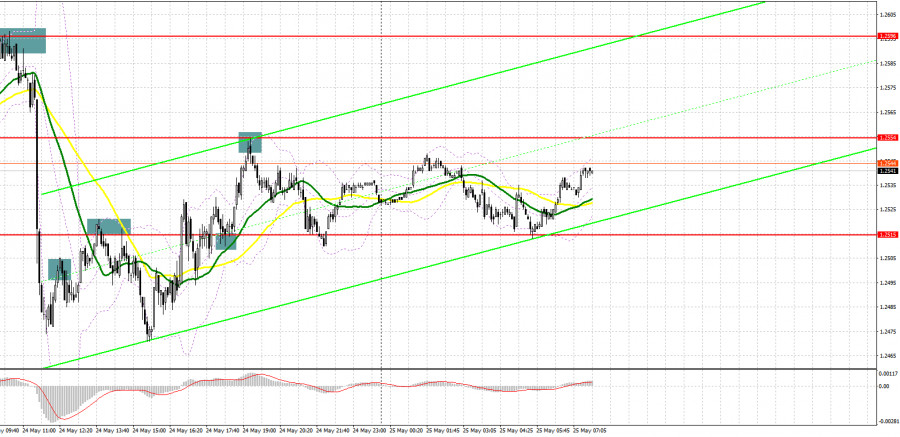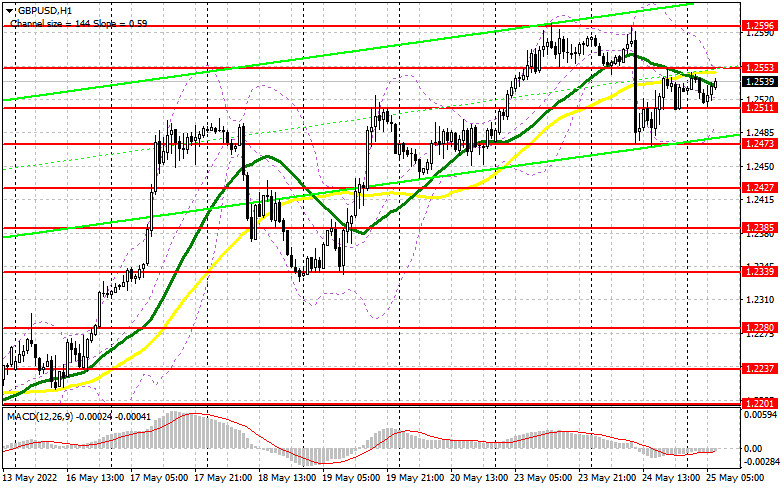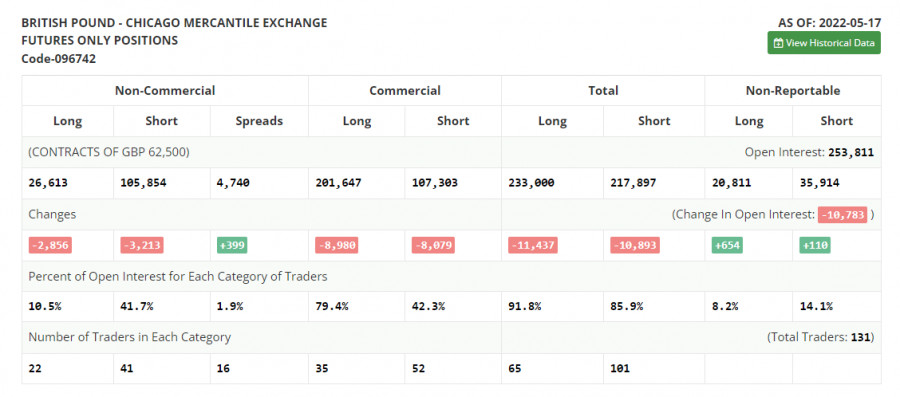Yesterday, a fairly large number of market entry signals were formed, which turned out to be quite profitable. Let's look at the 5-minute chart and see what happened. In my morning forecast, I paid attention to the level of 1.2596 and advised you to make decisions on entering the market from it. Growth and forming a false breakout at 1.2596, as well as a very disappointing report on economic activity in the UK - all this led to an excellent signal to sell the pound. As a result, the decline was more than 120 points. A little later there was a correction and a reverse test of 1.2500 from the bottom up, which led to a signal to open new short positions.
Despite the bears' attempt to immediately continue the pound's decline, the bulls began to buy out the lows, so the short position had to be postponed to the level of 1.2515, where a false breakout provided just an excellent entry point into the market. As a result, the fall was more than 40 points. In the middle of the US session, the bulls fought again for 1.2515 and settled above this range. Testing it from top to bottom became a signal for a long position, which brought about 35 points of profit. Protection at 1.2554 and a false breakout - a sell signal and another 40 points for you.
When to go long on GBP/USD:
Lack of UK statistics today should help bulls offset remaining losses from yesterday's big sell-off on the weak UK PMI data. No data - no problems, which will help to continue the growth in order to build a new upward trend. If the pound does not actively move up in the near future, the bulls will really have to think about defending 1.2511. Considering that trading is carried out in the area of moving averages, it is difficult to say which direction the market will choose. Forming a false breakout at 1.2511 will lead to a signal to open new long positions, counting on the continuation of the bullish trend with growth towards the intermediate resistance at 1.2553, which we failed to get above yesterday. It is possible to expect a sharper movement of the pair, but only after consolidating above this range with a reverse test from top to bottom, which may occur in the first half of the day, which will open the way to new weekly highs in the area of 1.2596 and 1.2643, where I recommend taking profits.
The next target will be the 1.2692 level. In case the pound falls and there are no bulls at 1.2511, the pressure will seriously increase, which will allow the pair to return to yesterday's low. Therefore, I advise you not to rush into long positions. It is best to enter the market after a false breakout in the area of 1.2473. You can buy GBP/USD immediately on a rebound only from 1.2427, or even lower - in the region of 1.2385, and only with the goal of correcting 30-35 points within the day.
When to go short on GBP/USD:
At the moment, protecting 1.2553 will help the bears return to the market in order to build a downward correction and return the pair to the 1.2511 area. False breakouts at 1.2553, by analogy with what I analyzed above, will be an ideal condition for opening short positions in anticipation of consolidating below 1.2511. Taking into account that bulls were brought to their senses yesterday by the weak statistics on the UK, and it is realistic to say that the situation is starting to gradually improve very early, we can count on a breakthrough and reverse test from below 1.2511, which forms another signal for short positions, allowing the pound to return to the area of a low like 1.2473 - at the same time leaving the possibility of further decline to 1.2427, where I recommend taking profits.
A more distant target will be the area of 1.2358, the test of which will cross out the upward trend in the pair. But hopes that this scenario will come true without good fundamental statistics on the US is unlikely to succeed today. If GBP/USD grows and traders are not active at 1.2553, another upsurge may occur against the background of stop orders being dismantled. In this case, I advise you to postpone short positions until the next major resistance at 1.2596. I also advise you to open shorts there in case of a false breakout. You can sell GBP/USD immediately for a rebound from the high of 1.2643, counting on the pair's rebound down by 30-35 points within the day.
COT report:
The Commitment of Traders (COT) report for May 17 showed that both long and short positions have decreased - the decline of the latter turned out to be much greater. This suggests that the market may be gradually approaching the bottom, and also that traders are enjoying quite attractive prices and despite the whole situation in the UK and uncertainty, they are gradually looking at the market.
I have repeatedly noted the presence of a number of problems in the UK economy, as a rather difficult situation with inflation and slowdown in economic growth make the Bank of England rush between two fires. But it is worth noting that despite all this, BoE Governor Andrew Bailey, in his recent interview noted that the central bank is not going to refuse to raise interest rates in the near future. But the same cannot be said about the policy of the Federal Reserve. Rumors have spread that the central bank plans to "pause" the cycle of raising interest rates as early as September this year, which will definitely have a negative impact on the positions of the US dollar and partially weaken it.
The May 17 COT report indicated that long non-commercial positions decreased by -2,856 to 26,613, while short non-commercial positions decreased by -3,213 to 105,854. level -79,598 to 79,241. The weekly closing price increased from 1.2313 to 1.2481.
Indicator signals:
Moving averages
Trading is conducted in the area of 30 and 50-day moving averages, which indicates some market uncertainty with the direction.
Note: The period and prices of moving averages are considered by the author on the H1 hourly chart and differs from the general definition of the classic daily moving averages on the daily D1 chart.
Bollinger Bands
In the event of a decline, the lower border of the indicator around 1.2510 will act as support. In case of growth, the area of 1.2555 will act as resistance.
Description of indicators
- Moving average (moving average, determines the current trend by smoothing out volatility and noise). Period 50. It is marked in yellow on the chart.
- Moving average (moving average, determines the current trend by smoothing out volatility and noise). Period 30. It is marked in green on the chart.
- MACD indicator (Moving Average Convergence/Divergence — convergence/divergence of moving averages) Quick EMA period 12. Slow EMA period to 26. SMA period 9
- Bollinger Bands (Bollinger Bands). Period 20
- Non-commercial speculative traders, such as individual traders, hedge funds, and large institutions that use the futures market for speculative purposes and meet certain requirements.
- Long non-commercial positions represent the total long open position of non-commercial traders.
- Short non-commercial positions represent the total short open position of non-commercial traders.
- Total non-commercial net position is the difference between short and long positions of non-commercial traders.












